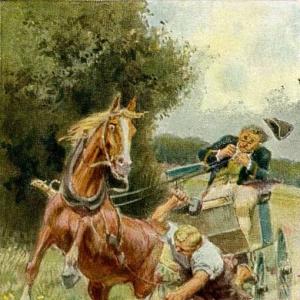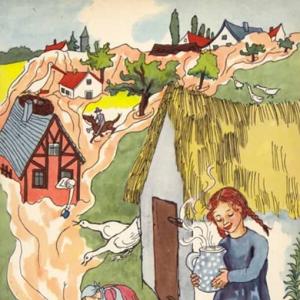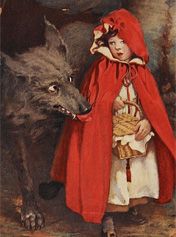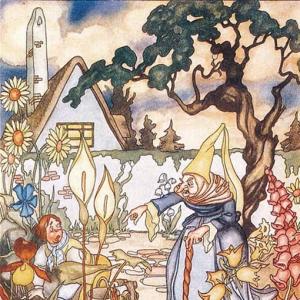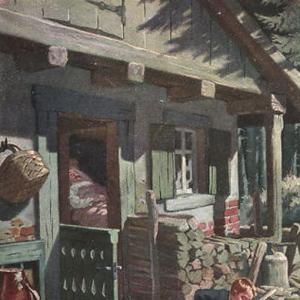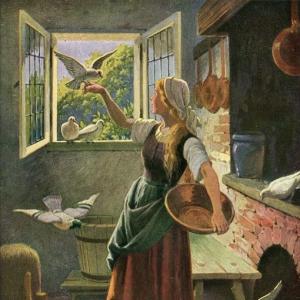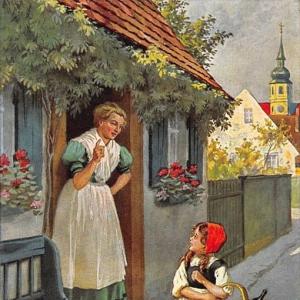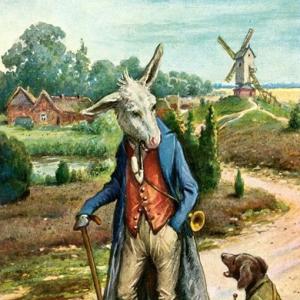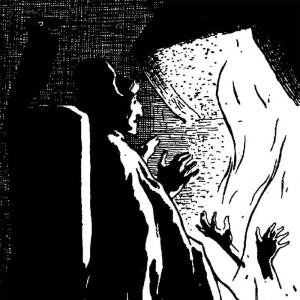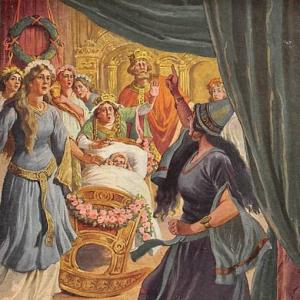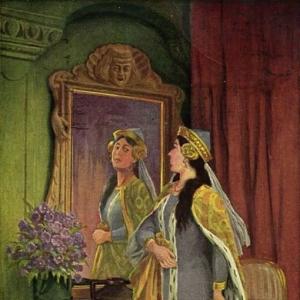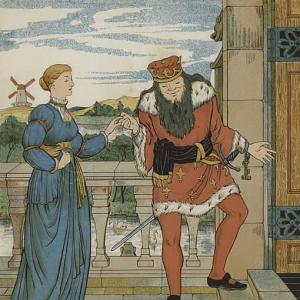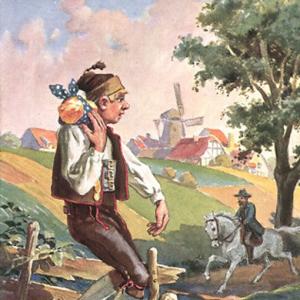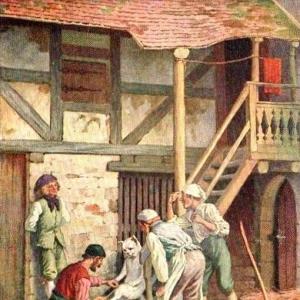Reading time: 12 min
You know the Goblin, but do you know the Woman, the Gardener’s wife? She was very well read and knew poems by heart. Yes, and she could write them, too, easily, except that the rhymes-clinchings, as she called them-gave her a little trouble. She had the gift of writing and the gift of speech. She could very well have been a parson or at least a parson’s wife.
„The earth is beautiful in her Sunday gown,“ she said, and this thought she had expanded and set down in poetic form, with „clinchings,“ making a poem that was so long and lovely. The Assistant Schoolmaster, Mr. Kisserup (not that his name matters at all), was her nephew, and on a visit to the Gardener’s he heard the poem. It did him good, he said, a lot of good. „You have soul, Madam,“ he said.
„Stuff and nonsense!“ said the Gardener. „Don’t be putting such ideas in her head! Soul! A wife should be a body, a good, plain, decent body, and watch the pot, to keep the porridge from burning.“ – „I can take the burnt taste out of the porridge with a bit of charcoal,“ said the Woman. „And I can take the burnt taste out of you with a little kiss. You pretend you don’t think of anything but cabbage and potatoes, but you love the flowers, too.“ Then she kissed him. „Flowers are the soul!“
„Mind your pot!“ he said, as he went off to the garden. That was his pot, and he minded it. But the Assistant Schoolmaster stayed on, talking to the woman. Her lovely words, „Earth is beautiful,“ he made a whole sermon of, which was his habit. „Earth is beautiful, and it shall be subject unto you! was said, and we became lords of the earth. One person rules with the mind, one with the body.
One comes into the world like an exclamation mark of astonishment, another like a dash that denotes faltering thought, so that we pause and ask, why is he here? One man becomes a bishop, another just a poor assistant schoolmaster, but everything is for the best. Earth is beautiful and always in her Sunday gown. That was a thought-provoking poem, Madam, full of feeling and geography!“
„You have soul, Mr. Kisserup,“ said the Woman, „a great deal of soul, I assure you. After talking with you, one clearly understands oneself.“ And so they talked on, equally well and beautifully. But out in the kitchen somebody else was talking, and that was the Goblin, the little gray-dressed Goblin with the red cap-you know the fellow. The Goblin was sitting in the kitchen, acting as pot watcher. He was talking, but nobody heard him except the big black Pussycat-„Cream Thief,“ the Woman called him.
The Goblin was mad at her because he had learned she didn’t believe in his existence. Of course, she had never seen him, but with all her reading she ought to have realized he did exist and have paid him a little attention. On Christmas Eve she never thought of setting out so much as a spoonful of porridge for him, though all his ancestors had received that, and even from women who had no learning at all.
Their porridge used to be so swimming with cream and butter that it made the Cat’s mouth water to hear about it. „She calls me just a notion!“ said the Goblin. „And that’s more than I can understand. In fact, she simply denies me! I’ve listened to her saying so before, and again just now in there, where she’s driveling to that boy whipper, that Assistant Schoolmaster. I say with Pop, ‚Mind the pot!‘ That she doesn’t do, so now I am going to make it boil over!“
And the Goblin blew on the fire till it burned and blazed up. „Surre-rurre-rup!“ And the pot boiled over. „And now I’m going to pick holes in Pop’s socks,“ said the Goblin. „I’ll unravel a large piece, both in toe and heel, so she’ll have something to darn. That is, if she is not too busy writing poetry. Madam Poetess, please darn Pop’s stocking!“ The Cat sneezed. He had caught a cold, though he always wore a fur coat.
„I’ve opened the door to the larder,“ said the Goblin. „There’s boiled cream in there as thick as paste. If you won’t have a lick I will.“ – „If I am going to get all the blame and the whipping for it, anyway,“ said the Cat, „I’ll lick my share of the cream.“ – „First a lick, then a kick!“ said the Goblin. „But now I’m off to the Assistant Schoolmaster’s room, where I’ll hang his suspenders on the mirror, put his socks into the water pitcher, and make him think the punch was too strong and has his brain in a whirl. Last night I sat on the woodpile by the kennel.
I have a lot of fun teasing the watchdog. I let my legs dangle in front of him. The dog couldn’t reach them, no matter how hard he jumped. That made him mad, he barked and barked, and I dingled and dangled. We made a lot of noise! The Assistant Schoolmaster woke up and jumped out of bed three times, but he couldn’t see me,though he was wearing his spectacles. He always sleeps with his spectacles on.“
„Say mew when you hear the Woman coming,“ said the Cat. „I’m a little deaf. I don’t feel well today.“ – „You have the licking sickness,“ said the Goblin. „Lick away; lick your sickness away. But be sure to wipe your whiskers, so the cream won’t show on it. I’m off to do a little eavesdropping.“ So the Goblin stood behind the door, and the door stood ajar. There was nobody in the parlor except the Woman and the Assistant Schoolmaster.
They were discussing things which, as the Assistant Schoolmaster so nobly observed, ought to rank in every household above pots and pans-the Gifts of the Soul. „Mr. Kisserup,“ said the Woman, „since we are discussing this subject, I’ll show you something along that line which I’ve never yet shown to a living soul-least of all a man. They’re my smaller poems. However, some of them are rather long. I have called them „Clinchings by a Danneqvinde“. You see, I am very fond of old Danish words!“
„Yes, we should hold onto them,“ said the Assistant Schoolmaster. „We should root the German out of our language.“ – „That I am doing, too!“ said the Woman. „You’ll never hear me speak of Kleiner or Butterteig. No, I call them fatty cakes and paste leaves.“ Then she took a writing book, in a light green cover, with two blotches of ink on it, from her drawer. „There is much in this book that is serious,“ she said. „My mind tends toward the melancholy. Here is my ‚The Sign in the Night,‘ ‚My Evening Red,‘ and ‚When I Got Klemmensen‘-my husband.
That one you may skip over, though it has thought and feeling. The Housewife’s Duties is the best one-sorrowful, like all the rest. That’s my best style. Only one piece is comical. It contains some lively thoughts-one must indulge in them occasionally-thoughts about-now, you mustn’t laugh at me-thoughts about being a poetess! Up to now it has been a secret between me and my drawer. Now you know it, too, Mr. Kisserup. I love poetry. It haunts me. It jeers, advises, and commands.
That’s what I mean by my title, „The Little Goblin.“ You know the old peasants‘ superstitions about the Goblin who is always playing tricks in the house. I myself am the house, and my poetical feelings are the Goblin, the spirit that possesses me. I have written about his power and strength in „The Little Goblin“; but you must promise with your hands and lips never to give away my secret, either to my husband or to anyone else. Read it loud, so that I can tell if you understand the meaning.“
And the Assistant Schoolmaster read, and the Woman listened, and so did the little Goblin. He was eavesdropping, you’ll remember, and he came just in time to hear the title „The Little Goblin.“ – „That’s about me!“ he said. „What could she have been written about me? Oh, I’ll pinch her! I’ll chip her eggs, and pinch her chickens, and chase the fat off her fatted calf! Just watch me do it!“
And then he listened with pursed lips and long ears; but when he heard of the Goblin’s power and glory, and his rule over the woman (she meant poetry, you know, but the Goblin took the name literally), the little fellow began grinnning more and more. His eyes brightened with delight. Then the corners of his mouth set sternly in lines of dignity. He drew himself up on his toes a whole inch higher than usual. He was greatly pleased with what was written about the Little Goblin.
„I’ve done her wrong! The Woman has soul and fine breeding! How, I have done her wrong! She has put me into her Clinchings, and they’ll be printed and read. Now I won’t allow the Cat to drink her cream. I’ll do that myself! One drinks less than two, so that’ll be a saving; and that I shall do, and pay honor and respect to the Woman!“
„He’s a man all right, that Goblin,“ said the old Cat. „Just one sweet mew from the Woman, a mew about himself, and he immediately changes his mind! She is a sly one, the Woman!“ But the Woman wasn’t sly. It was just that the Goblin was a man. If you can’t understand this story, ask somebody to explain it to you; but don’t ask the Goblin or the Woman, either.
 Learn languages. Double-tap on a word.Learn languages in context with Childstories.org and Deepl.com.
Learn languages. Double-tap on a word.Learn languages in context with Childstories.org and Deepl.com.Backgrounds
Interpretations
Adaptions
Summary
Linguistics
„The Goblin and the Woman“ is a fairy tale written by Hans Christian Andersen, a renowned Danish author. Andersen was born on April 2, 1805, in Odense, Denmark, and died on August 4, 1875, in Copenhagen, Denmark. He is best known for his fairy tales, which have become an essential part of children’s literature and have been translated into numerous languages.
Andersen’s stories often contain moral lessons and explore themes such as the power of imagination, love, and the triumph of good over evil. Some of his most famous works include „The Little Mermaid,“ „The Ugly Duckling,“ „The Emperor’s New Clothes,“ and „The Snow Queen.“ His stories have inspired countless adaptations in various forms, including films, plays, and musicals.
„The Goblin and the Woman“ is a lesser-known work by Andersen that features a mischievous Goblin and a woman who loves poetry. The story intertwines themes such as the power of words, the complexity of human nature, creativity, gender roles, and superstition, providing an engaging and thought-provoking narrative. Like many of Andersen’s other works, this tale showcases his ability to create imaginative worlds that captivate readers and offer valuable insights into human nature and society.
Hans Christian Andersen, a Danish author, is famous for his collection of fairy tales, which were written in the 19th century. He often drew inspiration from the folklore, myths, and legends of Denmark and other European countries. Andersen’s stories frequently contain moral lessons, exploring themes such as love, kindness, and the importance of inner beauty. In the case of „The Goblin and the Woman,“ Andersen drawn inspiration from European folklore about goblins or similar creatures, who are known to be mischievous, curious, and sometimes even malevolent. As with many of his stories, this fairy tale have been influenced by Andersen’s personal experiences, the cultural context of 19th-century Denmark, and the rich tradition of European folklore.
„The Goblin and the Woman“ offers various interpretations, some of which are:
The power of words and flattery: The story highlights how the power of words and flattery can have a significant impact on people’s (and goblins‘) behavior. The Goblin changes his mind about the woman after hearing the poem that he believes is about him. This shows that recognizing and appreciating someone’s worth can lead to positive outcomes.
The duality of human nature: The tale demonstrates the complexity and duality of human nature, as seen in the characters of the woman, the Assistant Schoolmaster, and the Goblin. The woman is both a dutiful wife and a poetess. The Assistant Schoolmaster is an intellectual and a superstitious man. The Goblin is mischievous yet appreciative when he feels valued. This emphasizes that people can have multiple facets to their personalities.
Imagination and creativity: The story celebrates the value of imagination, creativity, and the arts, as exemplified by the woman’s love for poetry. Through her passion, she manages to win the Goblin’s favor without even realizing it, highlighting the impact that creativity can have on the world around us.
Gender roles and expectations: The gardener’s insistence that his wife should focus on practical matters and housekeeping reflects the traditional gender roles and expectations that women faced. The woman, however, defies these expectations by pursuing her passion for poetry and expressing her thoughts and emotions through her writing.
Superstition and folklore: The tale incorporates elements of superstition and folklore, such as the existence of the Goblin and the old peasants‘ beliefs about him. This adds a layer of cultural context and richness to the story, showcasing Andersen’s ability to weave traditional folklore into his narratives.
Overall, „The Goblin and the Woman“ is a multifaceted tale that invites readers to explore themes such as the power of words, the complexity of human nature, creativity, gender roles, and superstition.
While „The Goblin and the Woman“ is not as widely adapted as some of Hans Christian Andersen’s other fairy tales, there have been a few adaptations and retellings of the story.
Illustrated editions: Various illustrated editions of Andersen’s fairy tales include „The Goblin and the Woman,“ with illustrations by artists like Vilhelm Pedersen, Lorenz Frølich, or Edmund Dulac, among others. These illustrations bring the story to life visually, allowing readers to connect with the characters and the magical world depicted in the story.
Children’s books: The story has been adapted into children’s books, often with simplified language and additional illustrations to engage young readers. These adaptations usually focus on the themes of curiosity, imagination, and the power of art, making the story accessible and enjoyable for children. „The Goblin and the Grocer“ (2017): This children’s book by Sabine Ludwig is a humorous retelling of Andersen’s tale. It features lively illustrations and a lighthearted tone, and emphasizes the story’s message about the importance of honesty and kindness.
Audiobooks: „The Goblin and the Woman“ has been included in collections of Hans Christian Andersen’s fairy tales in audiobook format, narrated by various voice actors. These audiobooks bring a new dimension to the story, as the narrator’s voice and storytelling skills create an immersive listening experience.
Television: „The Goblin and the Grocer“ (1990): This German television adaptation is a live-action retelling of Andersen’s tale. It features a talented cast and stays true to the story’s themes of greed and personal transformation.
Animation Movies: While there are no specific examples of a standalone animated adaptation of „The Goblin and the Woman,“ the story has been included in anthologies of Andersen’s fairy tales in animated format. These adaptations often use colorful and imaginative animation to bring the story to life, appealing to children and adults alike. „The Goblin and the Grocer“ (2003): This Finnish animated short film is a modern retelling of Andersen’s tale. It features computer-generated animation and a contemporary score, and adds a humorous twist to the story’s ending. „The Goblin and the Grocer“ (1971): This Danish animated film is a faithful adaptation of Andersen’s fairy tale. It features whimsical animation and a playful score, and stays true to the story’s message about the dangers of greed. „The Goblin and the Huckster“ (1986): This Soviet animated film is another faithful adaptation of Andersen’s tale. It features beautiful animation and a score that blends classical and folk music. The story is adapted to a rural setting, which adds a unique flavor to the tale.
„The Goblin and the Woman“ by Hans Christian Andersen has been adapted in various forms of media, including films, television shows, and books. Though „The Goblin and the Woman“ has not been adapted as extensively as other Andersen fairy tales, it still resonates with readers and audiences through these various retellings and adaptations, highlighting the universal themes and imaginative storytelling that Andersen is known for. These adaptations showcase the enduring popularity and relevance of Andersen’s tale, and how it can be interpreted and adapted in various ways to resonate with different audiences.
„The Goblin and the Woman“ is a fairy tale by Hans Christian Andersen about a woman who is married to a gardener and is very well-read, knowledgeable about poems, and can even write them. She has a knack for writing and speaking and is admired by her nephew, the Assistant Schoolmaster, Mr. Kisserup, who believes she has a great soul. The gardener, however, believes that his wife should focus more on practical matters, such as cooking and maintaining the household.
Meanwhile, a mischievous Goblin lives in the woman’s house, angry at her for not acknowledging his existence. He causes chaos in the household, such as making pots boil over, unravelling socks, and teasing the watchdog. The Goblin eavesdrops on the woman and the Assistant Schoolmaster discussing poetry and the soul, and he learns that the woman has written a poem called „The Little Goblin.“
The Goblin assumes the poem is about him and is initially furious, but upon hearing how powerful and glorious he is portrayed, he becomes pleased and decides to treat the woman with respect. The story ends with the woman unknowingly winning the Goblin’s favor, and the cat observing that the Goblin’s change of heart was due to the woman’s ability to influence him. The tale is a humorous reflection on the power of words and the unpredictable nature of people (and goblins).
Linguistic analysis of Hans Christian Andersen’s fairy tale „The Goblin and the Woman“ reveals a complex interplay of themes, character dynamics, and language use that reflect both the narrative’s whimsical nature and its deeper societal commentary.
Characterization and Dialogue
The Woman: She is portrayed as intelligent and creatively inclined, with a knack for poetry. Her dialogue, rich in metaphors („The earth is beautiful in her Sunday gown“), reveals both her poetic nature and her desire to express herself beyond domestic confines. Her use of the word „clinchings“ for rhymes suggests a playful yet earnest engagement with language.
The Gardener: His practical, down-to-earth nature contrasts with his wife’s intellectual pursuits. His dialogue reflects traditional views of gender roles, emphasizing domestic responsibilities over intellectual or artistic pursuits.
The Assistant Schoolmaster, Mr.
Kisserup: His interactions with the Woman highlight the theme of intellectual companionship and validation. He appreciates her work and engages in discussions about soul and intellect, providing a counterpoint to the Gardener’s more prosaic views.
The Goblin: The Goblin’s speech is colloquial and mischievous. His reaction to not being believed in highlights themes of recognition and appreciation. The Goblin’s whimsical, trickster-like language and actions (e. g. , making the pot boil over, messing with the Schoolmaster’s belongings) provide comic relief while also serving as a narrative device to highlight the Woman’s imaginative spirit.
Themes and Symbolism
The Gifts of the Soul vs. Domestic Duty: The story juxtaposes the Woman’s intellectual and creative aspirations with her domestic responsibilities, highlighting the tension between personal fulfillment and societal expectations. The Gardener’s emphasis on her physical presence in domestic duties contrasts with the Schoolmaster’s appreciation of her soul and intellect.
Recognition and Misunderstanding: The Goblin’s initial resentment stems from a lack of recognition. However, once he misunderstands the Woman’s poem as a literal homage to him, he feels validated. This reflects on the human need for acknowledgment and the power of perception.
Literary Devices: Andersen uses a humorous tone, irony, and a touch of the supernatural. The Goblin, embodying mischief and chaos, becomes an allegory for the creative spirit, misunderstood yet integral to the character’s life and expression.
Language and Style: Andersen’s use of language oscillates between poetic expressions and everyday speech. This contrast serves to bridge the fantastical elements with the ordinary world, making the story engaging while grounded in reality. The Woman’s discourse is marked by poeticism, evident in her discussions and the titles of her poems („The Sign in the Night,“ „My Evening Red“), while the Gardener’s speech is simple and unembellished, enhancing the thematic dichotomy.
Cultural and Social Commentary: The narrative subtly critiques gender norms and societal expectations. The Gardener’s views reflect patriarchal attitudes towards women’s roles, while the Woman’s intellectual pursuits highlight her resistance to these confines. The conversation about language („We should root the German out of our language“) may also reflect nationalistic sentiments of Andersen’s time, emphasizing cultural identity and the preservation of Danish heritage.
Overall, „The Goblin and the Woman“ is a multifaceted tale that uses character dynamics, linguistic contrasts, and thematic depth to explore issues of recognition, gender roles, and the intersection of the mundane with the imaginative.
Information for scientific analysis
Fairy tale statistics | Value |
|---|---|
| Translations | DE, EN, DA, ES, IT |
| Readability Index by Björnsson | 23.8 |
| Flesch-Reading-Ease Index | 85.3 |
| Flesch–Kincaid Grade-Level | 4.3 |
| Gunning Fog Index | 6.3 |
| Coleman–Liau Index | 8.2 |
| SMOG Index | 7.9 |
| Automated Readability Index | 3.6 |
| Character Count | 8.913 |
| Letter Count | 6.744 |
| Sentence Count | 142 |
| Word Count | 1.654 |
| Average Words per Sentence | 11,65 |
| Words with more than 6 letters | 201 |
| Percentage of long words | 12.2% |
| Number of Syllables | 2.145 |
| Average Syllables per Word | 1,30 |
| Words with three Syllables | 94 |
| Percentage Words with three Syllables | 5.7% |

 Facebook
Facebook  Whatsapp
Whatsapp  Messenger
Messenger  Telegram
Telegram Reddit
Reddit